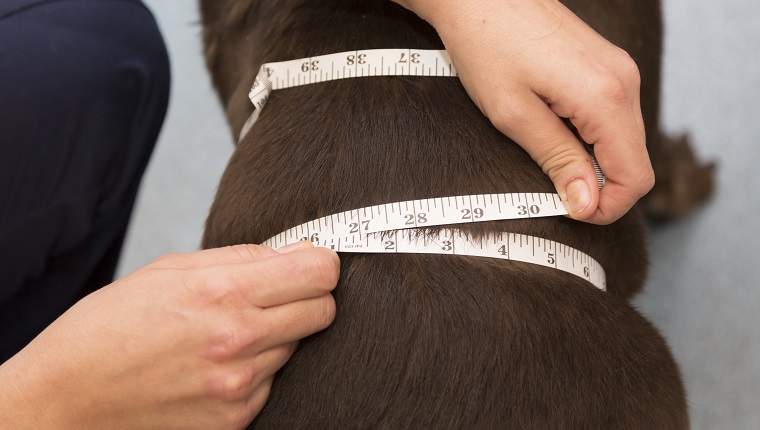Most dogs would gladly eat all the junk food you put in front of them. However, as pet parents, we know that we’re the ones who have to make responsible decisions for our canine companions’ health.
Weight is a significant contributor to the overall health of dogs, and obesity can lead to problems like diabetes, worsened arthritis, heart and circulation issues, breathing problems, and more.
If you’re reading this, you may be concerned that your dog is overweight, and considering over 50 percent of dogs in the United States are overweight or obese, your concern is justified. Nutrition and exercise can help get your pup back in shape, but first you have to find out whether your dog needs to shed some pounds.
Here are six ways to tell if your dog is overweight.
1. Visit The Vet

Chances are good that if you’re already wondering if your dog is overweight, they probably are.
The best way to find out for sure, however, is to take a trip to the vet. No matter how many at-home tests you do, it isn’t always possible to tell whether your dog is at a healthy weight unless you are an expert.
Your dog’s breed, age, size, and medical conditions can all affect what their appropriate weight should be, and your veterinarian will be far better equipped to figure out whether your dog is healthy.
The other benefit of going to the vet is that they can discuss treatment with you right away and recommend safe ways to adjust your dog’s diet and exercise routine. When it comes to your dog’s weight, your vet is your best bet.
2. Body Is Eggplant-Shaped Instead Of Hourglass-Shaped
Look at your dog’s body from above. If they’re shaped more like a bullet or an eggplant, chances are good that they’re overweight.
Certain breeds are shaped differently, which is why it’s best to see a vet, but the general rule is that dogs should be a little bit hourglass-shaped from above. They should have a noticeable curve or waistline above the hip.
Also, if you look at your dog from the side, their belly should not swing at all. Most dogs are naturally lean when healthy. You shouldn’t be able to see their ribs, but they also shouldn’t have extra weight that sags or swings around the middle, either.
3. Can’t Feel Ribs

When you run your fingers over your dog’s abdomen, you should be able to feel their ribs through the skin without applying pressure. If your dog has a thicker coat, you may need to move some fur to feel.
Your pup should have a fairly thin padding of muscle and fat over the ribs, too. You should not be able to see your dog’s ribs, or your pooch may actually be underweight.
Again, factors like breed, age, and illness can affect what will be considered a healthy weight for your dog, so you should ask your vet for their advice.
4. Tiredness & Poor Mobility

Carrying extra weight is exhausting and sometimes even painful. If your dog is having difficulty getting up, avoiding play or exercise, and showing signs of pain, they may be overweight.
If your dog seems more tired than usual or prefers to stay in bed more than they usually do, their weight may be the cause.
Symptoms of arthritis and other medical conditions can be worsened by having extra weight.
It’s also important to note that other illnesses and conditions may cause your dog to feel tired, suffer from pain, or have difficulty moving. So if you see signs that your dog isn’t behaving like normal or enjoying the activities they used to, you should absolutely see a vet.
5. Trouble Breathing

Extra weight puts stress on the heart, lungs, and circulatory system, meaning it’s harder for your dog’s body to pump oxygen-filled blood to where it needs to go.
To compensate, your dog might start breathing harder. They may cough more or show signs of poor circulation.
If your dog has trouble breathing, you must see a vet right away! While your dog’s weight may be a factor, it’s also possible that they’re suffering from another medical condition that needs veterinary attention.
6. Frequent Tummy Issues

Digestive troubles often go hand-in-hand with extra weight. If your dog suffers from frequent constipation, indigestion, acid reflux, gas, and other gastrointestinal problems, it could be a sign that your pooch needs to lose pounds.
These could also be signs of other medical conditions, so it’s important that you talk to your vet.
Almost all dogs have occasional digestive issues, but if they’re becoming more common, then something is wrong.
Do you regularly check that your dog is at an appropriate weight? What does your vet recommend for keeping your pup in shape? Let us know in the comments below!









